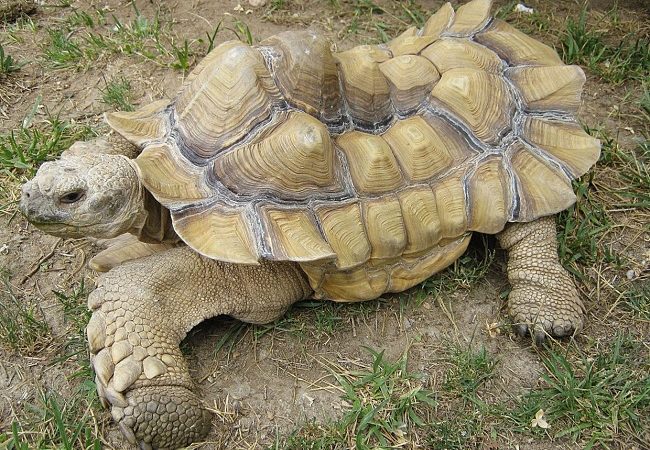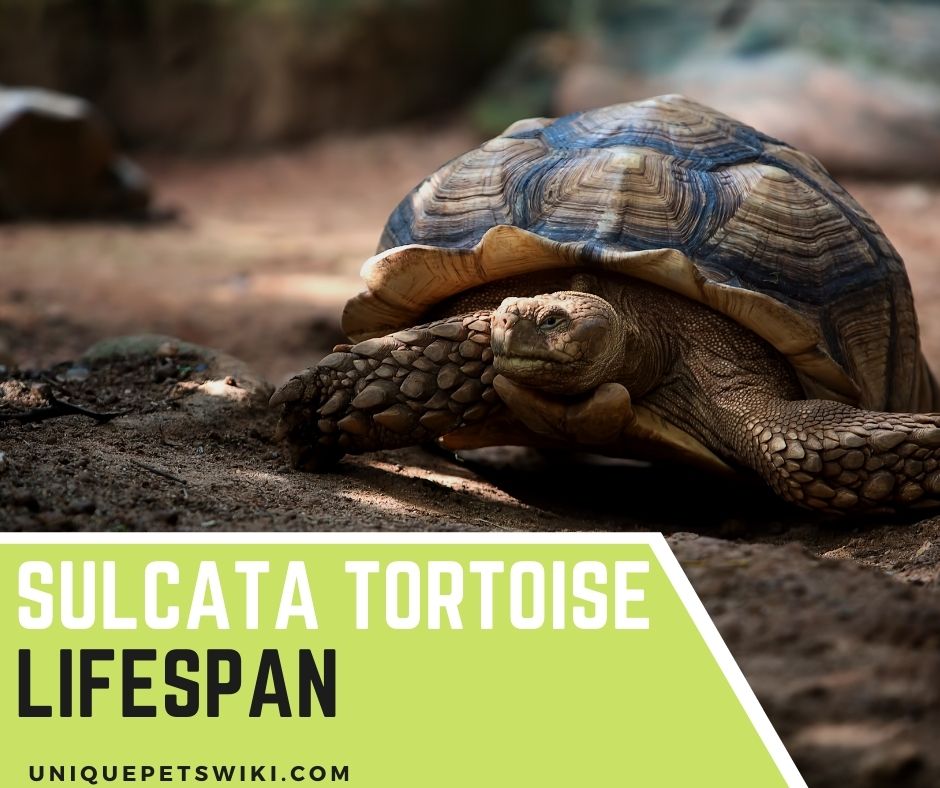Sulcata tortoise, also called African spurred tortoise, is among the largest tortoise species in the world. They are a perfect pet that you can keep as a pet because they can adapt to a wide range of living conditions. However, they are not suitable for everyone because they require specific care and have a long lifespan.
Before choosing a sulcata tortoise as a pet, it is best to know how long they can live to help prepare yourself for the long-term commitment. Sulcata tortoises have a long lifespan and can live anywhere for around 60-100 years under optimal care.
In this article, we will help highlight everything you need to know about sulcata tortoise lifespan, from how long they can live to factors that can affect their lifespan.
Contents
Sulcata Tortoise Overview
Sulcata tortoises are hardy tortoise species that originate from the arid and semiarid areas of Africa. You can identify them by their brown to yellow shell and skin, along with the pointed scales on their legs.
They are the third largest mainland tortoise as they can grow to about 30 inches long and weigh over 100 pounds. Furthermore, some males can even weigh around 200 pounds. Sulcatas are bred and sold throughout the US, which makes getting one as a pet quite easy.
However, they grow quickly and can grow extremely large, making them unmanageable for some owners and usually in need of a new home. Apart from having a docile temperament, sulcata tortoises are also curious and intelligent reptiles.
Furthermore, you should not handle them regularly, as excessive handling can stress your tortoise out.

Sulcata Tortoise Lifespan
When compared to conventional pets, sulcata tortoises have a long lifespan. They can live for about 60-70 years, but there are cases where they even live more than 100 years. Sulcatas usually have higher life expectancies when raised under optimal conditions.
Sulcata Tortoise Lifespan In Captivity
The average lifespan of sulcata tortoises in captivity is about 54.3 years. However, they can live for up to 150 years if provided with proper diet, environment, and care. Keeping tortoises in captivity usually works in their favor as they get to enjoy a balanced diet with regular medical checkups, which boost their health.
This is why you should consider their lifespan whenever you plan to choose a sulcata tortoise as a pet. You need to ensure that you are financially and mentally ready for the long-term commitment of keeping them as a pet.
Sulcata Tortoise Lifespan In The Wild
The average life expectancy of sulcata tortoises in the wild is 50 years. Just like captive sulcatas, wild sulcata tortoise can also live up to about 150 years. However, in the wild, sulcatas live in an arid region and will have to hunt for food and fight off any predators.
Furthermore, wild sulcata tortoises do not have the opportunity for emergency medical care and will have to heal naturally. This means wild sulcatas can have a shorter lifespan, unlike captive-bred ones.
Signs Of A Healthy Sulcata Tortoise
Some of the signs of a healthy sulcata tortoise are stated below.
Activity Level
Unless your tortoise’s body temperature is cold, it should be able to move around quickly. A healthy tortoise is usually active, and they walk while their shell’s bottom is clear of the ground. A healthy tortoise can also move objects away and even try to squeeze through minor gaps.
They will also have a good muscle tone in their limbs as well. Furthermore, a healthy tortoise usually has strong muscles and will resist if you gently push or tug on their leg. However, your tortoise may be dehydrated if it is weak and flaccid.
The Shell
The top of a healthy sulcata tortoise’s shell is usually smooth, firm to touch, and doesn’t have any signs of injury. Furthermore, healthy tortoises usually feel solid rather than light whenever you are holding them.
Plastron
The plastron of a tortoise’s shell is the tortoise’s tummy. A healthy tortoise plastron is usually hard like the shell’s top. However, hatchlings may have a softer plastron that hardens up quickly. A healthy tortoise’s plastron is usually well-sealed, smooth, and will be free from damage.
Your tortoise may be suffering from internal damage if its plastron is scarred or you detect any new injuries there. This can happen from dog bites, maltreatment, or if your tortoise falls on hard surfaces.
Skin
A healthy tortoise usually has rugged and tough skin, which helps them to fend off barbs and tough terrain. Furthermore, they have wrinkly and dry skin, and there may be a problem if it looks moist or wet. You may also need to visit the vet if your tortoise skin is very dry, which then causes sores and cracks.
You also need to be on the lookout for mites, ticks, and other parasites on your tortoise’s skin.
The Eyes

A healthy tortoise usually has a clear and bright eye without any sign of discharge.
The Nose
Tortoise has a great sense of smell used for identifying their food. A healthy tortoise usually has a clear and dry nose without any sign of discharge.
The Mouth
A healthy tortoise has a clear and pink tongue, except it is stained by their recent meal. They also have a strong bite even though they don’t have any teeth.
Tail
Many people overlook the tortoise’s tail when checking if it is healthy or not. A healthy tortoise has a clean tail, which means there are no urates or feces around it. You can also check whether there is any sign of skin crack, sores, irritation, or damage around their tail area.

Faeces And Urine
A healthy tortoise has firm, dry, and well-formed faeces. Furthermore, they excrete clear urine, and their urates usually range from being watery to soft like toothpaste. Once you notice that their faeces are loose or watery, they may suffer from sickness.
Once you notice that their urates are hard or gritty, they may be suffering from an illness.
Factors That Affects Sulcata Tortoise Lifespan
In this section, we will highlight some of the things that can affect the lifespan of your sulcata tortoise.
Environment
Sulcata tortoises originate from deserts or arid areas and are well adapted to this kind of weather. This shows they will need desert-type land soil with grassy areas even when keeping them as a pet. You will also need to add dirt and other substrates to their enclosure.
However, your sulcata tortoise feels uncomfortable when you keep them in a habitat that does not meet these requirements. This can then cause mental stress and other diseases that can affect their lifespan. Furthermore, predators can affect the lifespan of your tortoise.
If a tortoise’s environment is surrounded by natural predators like raccoons, opossums, snakes, eagles, skunks, crows, dogs, and cats, they may prey on the tortoise. This is one of the reasons why the average age of tortoises in the wild is quite lower than how old they can live.
Diet
Tortoise get most of the nutrients and vitamins they need to function well from their diet. This means your tortoise can live for a long time if you provide it with a good and balanced diet. However, if you provide a poor diet for your tortoise, then their lifespan will be relatively short.
In the wild, sulcata tortoises don’t have access to a stable and balanced diet, usually affecting their lifespan. However, pet tortoises will feed on what you give them, and if you can feed them with a balanced diet, they will have a long lifespan.
Diseases
Like other animals, sulcata tortoises can suffer from a wide range of diseases. Furthermore, diseases can then decrease the lifespan of your tortoise. Some of the health conditions that can affect sulcata tortoises are:
- Pyramiding
- Dehydration
- Bacterial or fungal infection
- Bladder stone
- Paralysis
- Metabolic bone diseases
- Organ failure
Furthermore, pet sulcatas usually get more medical attention, unlike the wild ones. This shows that captive tortoises can live longer than those in the wild.

Conservation Of Sulcata Tortoise
Sulcata tortoises are listed as a vulnerable species by the International Union for Conservation of Nature (IUCN). They are threatened due to habitat loss and the over-collection in the pet trade.
Wrapping Up
Sulcata tortoises are considered to be among the largest and easiest tortoise species that you can keep as a pet. Furthermore, they are suitable for beginner hobbyists if you are ready for the commitment. This is because they can live for about 50-150 years.
Furthermore, their lifespan depends on numerous factors, but they can live to their fullest if you provide them with optimal care.
